Orion’s Sword is a prominent asterism located below the brighter Orion’s Belt in the constellation Orion. It is part of the recognizable constellation figure representing the celestial Hunter. It is formed by several points of light: 42 Orionis, Theta Orionis, Iota Orionis, and the bright, large Orion Nebula (Messier 42). The stellar nursery appears as the central point of light in the Sword. The entire region hosts several star clusters and nebulae, as well as many multiple star systems composed of very young stars.
Orion’s Sword is one of three major asterisms in the constellation Orion, along with the brighter Orion’s Belt and fainter Orion’s Shield. The constellation figure of Orion represents the giant hunter in Greek mythology, who is usually depicted facing the charge of the Bull (Taurus) or chasing the hare represented by the constellation Lepus. The nearby constellations Canis Major and Canis Minor (the Greater and Smaller Dog) represent Orion’s dogs.
In Greek lore, Orion met his end when he was stung by a scorpion, represented by the constellation Scorpius. It is said that the two constellations were placed at opposite ends of the sky because the Hunter is still fleeing from the Scorpion.
The Sword asterism has been associated with a sword since ancient times. Latin translations of the 3rd century BCE Greek poet Aratus’ Phaenomena mention it as ensis (Latin for “sword”). In Arabic astronomy, the asterism was also associated with a sword and called Saif al Jabbār, meaning “sword of the giant.” The star Kappa Orionis at Orion’s right knee is formally named Saiph (“sword”) even though it is not part of the asterism.
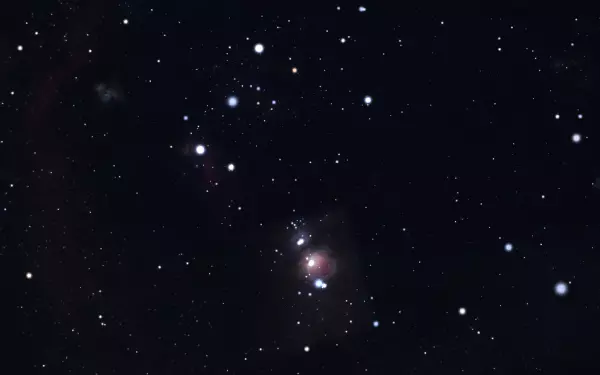
Orion’s Sword, image: Stellarium
The region of Orion’s Sword is populated by several bright deep sky objects that make excellent targets for backyard telescopes. In addition to the Orion Nebula (Messier 42) with the Trapezium Cluster, these are De Mairan’s Nebula (Messier 43), the Running Man Nebula (NGC 1977) and the open cluster NGC 1980. Fainter stars, star clusters and patches of nebulosity make the Sword a popular target for astrophotography.
The three points of light that constitute the Sword of Orion are the multiple star system 42 Orionis in the Running Man Nebula, the Trapezium Cluster (Theta1 Orionis) and the multiple star system Theta2 Orionis in the centre of the Orion Nebula, the Orion Nebula itself, and the multiple star system Iota Orionis (Hatysa) in the open cluster NGC 1980.
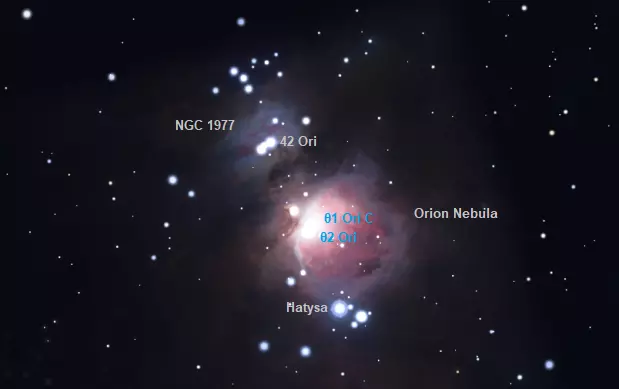
The components of Orion’s Sword, image: Stellarium
42 Orionis
42 Orionis (c Orionis) is a very young blue main sequence star located approximately 900 light years away. It is one of the stars that illuminate the Running Man Nebula (NGC 1977), a reflection nebula embedded in a larger H II region catalogued as Sharpless 279 (Sh2-279).
42 Orionis is a blue main sequence star of the spectral type B1 V. It has a mass 12 times that of the Sun and a surface temperature of 25,400 K. Shining at magnitude 4.59, it is visible to the unaided eye. The star has two companions: a magnitude 6.3 spectroscopic companion at a separation of 0.16 arcseconds and a magnitude 7.5 companion 1.6 arcseconds away.
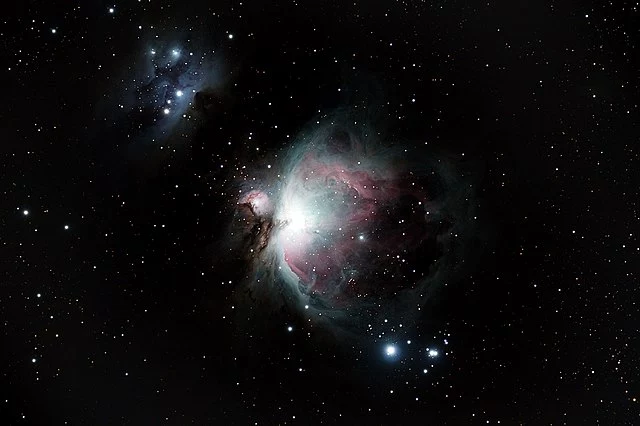
The Orion Nebula and the Running Man Nebula, image: Wikimedia Commons/Astro.sin (CC BY-SA 4.0)
Running Man Nebula
The Running Man Nebula is a popular target for small and medium telescopes because it appears in the same wide field as the larger Orion Nebula. It is a reflection nebula within the larger H II region Sharpless 279 (Sh2-279).
Sharpless 279 lies 0.6 degrees north of the brighter Orion Nebula and consists of three nebulae catalogued separately in the New General Catalogue as NGC 1973, NGC 1975, and NGC 1977, and the open cluster NGC 1981. It is the northernmost part of Orion’s Sword. It has an apparent size of 40 by 25 arcminutes and an apparent magnitude of 7.0. It lies approximately 1,500 light years away.
The Running Man Nebula is visible in small telescopes, but the silhouette of the running man can only be captured photographically.
In 2021, NASA’s Hubble Space Telescope imaged a jet from a newly formed star in the nebula, catalogued as Parengo 2042, that stretched over 2 light years. The gas in the jet was ionized and made visible by the radiation of 42 Orionis.
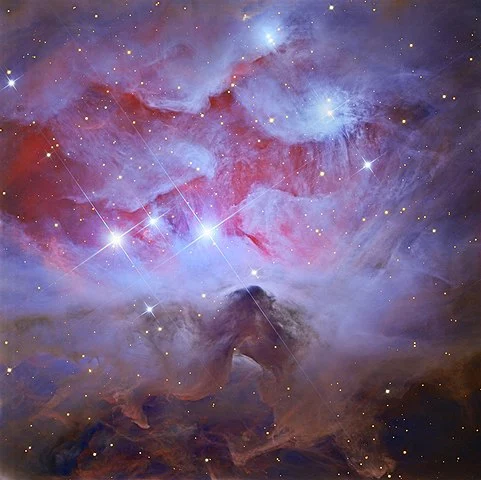
Running Man Nebula (NGC 1977), image: Adam Block/Mount Lemmon SkyCenter/University of Arizona (CC BY-SA 4.0)
Theta Orionis
The Bayer designation Theta Orionis is shared by the Trapezium Cluster (Theta1 Orionis) and the multiple star system Theta2 Orionis, which lies in the same region. Theta1 Orionis has the Flamsteed designation 41 Orionis and Theta2 is catalogued as 43 Orionis.
Theta1 Orionis consists of components designated Theta1 Orionis A, B, C, D, E, F, G, and H. Some of these are double and multiple star systems. Together, they form the Trapezium Cluster, a very young open cluster at the heart of the Orion Nebula.
Trapezium Cluster (Theta1 Orionis)
The Trapezium Cluster is a tight open cluster that lies at the centre of the Orion Nebula. Its six brightest stars are easily resolved in 5- and 6-inch telescopes. The stars of the cluster were formed within the larger Orion Nebula. The estimated age of the cluster is only 300,000 years.
The Trapezium gets its name from the asterism formed by its four brightest stars, designated Theta1 Orionis A, B, C and D. The brightest of these, Theta1 Orionis C, has an apparent magnitude of 5.13 and is visible to the unaided eye, even if it cannot be resolved from the rest of the cluster without optical aid. The components A and B are known to be eclipsing binary stars.
The Trapezium is part of the Orion Nebula Cluster, a much larger association of stars that stretches 20 light years across. The association is believed to have about 2,800 member stars. A 2012 study of the dynamical evolution of the Orion Nebula Cluster explained the large velocity dispersion of the four Trapezium stars by suggesting that a member star may have collapsed directly into a black hole with a mass of at least 100 solar masses. The study demonstrated that there was a 70% probability that the black hole was part of a binary system.
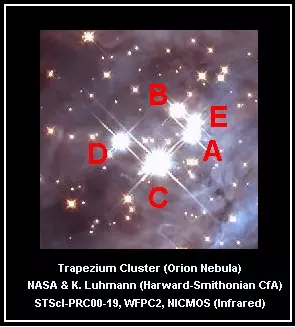
Trapezium Cluster stars, image: NASA, K. Luhmann, J. Barkmann (Hubble Space Telescope)
The Trapezium Cluster was discovered by Galileo Galilei, who sketched the components A, C and D in February 1617. Eight components were known by 1888.
The stars of the Trapezium are exceptionally massive. The five brightest members have masses in the range from 15 to 30 solar masses and illuminate the surrounding nebula. They are all within 1.5 light years of each other. The entire cluster has a radius of 10 light years. The cluster also contains brown dwarfs and low-mass runaway stars.
Theta1 Orionis A is a triple star classified as an Algol-type eclipsing binary. Its brightness varies from magnitude 6.72 to 7.65 over a period of 65.432 days. It has the variable star designation V1016 Orionis. The system has the stellar classification B0.5 V, indicating a hot, young blue main sequence star. It lies approximately 1,240 light years away.
The primary component, Theta1 Orionis A1, has a mass of 15.3 solar masses and a radius 4.5 times that of the Sun. It is 16,200 times more luminous than the Sun with an effective temperature of 30,700 K. The star is less than 2.5 million years old. It has a spectroscopic companion at a separation of only 1 astronomical unit. The companion may be a T Tauri star – a variable pre-main-sequence star less than 10 million years old – of the spectral type A.
Theta1 Orionis A2 appears at a separation of only 0.2 arcseconds from the primary. This corresponds to a physical separation of 90 astronomical units.
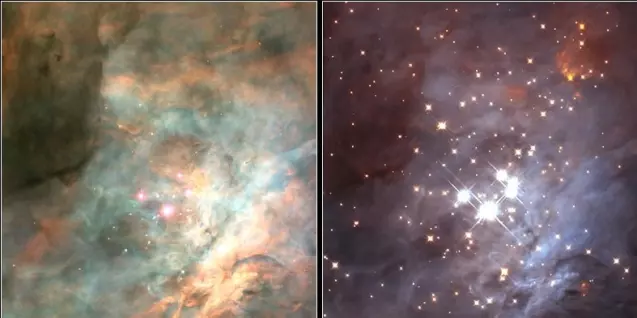
Two views of the Trapezium cluster in the Orion Nebula, from the Hubble Space Telescope. The image on the left, an optical spectrum image taken with Hubble’s WFPC2 camera, shows a few stars shrouded in glowing gas and dust. On the right, an image taken with Hubble’s NICMOS infrared camera penetrates the haze to reveal a swarm of stars as well as brown dwarfs. Credits for near-infrared image: NASA; K.L. Luhman (Harvard-Smithsonian Center for Astrophysics, Cambridge, Mass.); and G. Schneider, E. Young, G. Rieke, A. Cotera, H. Chen, M. Rieke, R. Thompson (Steward Observatory, University of Arizona, Tucson, Ariz.). Credits for visible-light picture: NASA, C.R. O’Dell and S.K. Wong (Rice University)
Theta1 Orionis B is a multiple star system consisting of five or more components. Like Theta1 Orionis A, it is classified as an Algol variable. It shines at magnitude 7.90 and drops to magnitude 8.65 every 6.47 days. The primary component is a blue main sequence star of the spectral type B1 V. It has a mass 6 times that of the Sun and a radius 3 times solar. It is 776 times more luminous than the Sun with a surface temperature of 19,320 K. The star is a fast rotator, spinning at 170 km/s. It has a spectroscopic companion with 2 solar masses and an effective temperature of 5,740 K.
Theta1 Orionis C is the brightest and most massive of the Trapezium stars. It has an apparent magnitude of 5.13. It is a blue main sequence star of the spectral type O6 Vp. It has a mass about 33 times that of the Sun and a radius 10.6 times solar. It shines with 204,000 solar luminosities with a surface temperature of about 39,000 K. The star is believed to be about 2.5 million years old. It has a companion, a blue main sequence star with the stellar classification B0 V. The companion has a mass 11 times that of the Sun. The two stars orbit each other with a period of 11.05 years and are separated by 40 arcseconds. They have a fainter companion that appears to be escaping the system.
Theta1 Orionis D is another blue main sequence star with a spectroscopic companion. The stars orbit each other with a period of 40 days. The primary component shines at magnitude 6.70 and has the stellar classification B1.5 Vp. It has a mass about 18 times that of the Sun and a radius 5.6 times solar. It is 29,500 times more luminous than the Sun with an effective temperature 32,000 K. Its estimated age is 2.5 million years. It may have another companion at a separation of 18.6 milliarcseconds.
Theta1 Orionis E is a spectroscopic binary system composed of two very similar pre-main-sequence stars in a close 10-day orbit. The system has the stellar classification G2 IV, which means that it presents as a yellow subgiant even though the stars are not yet on the main sequence. They are believed to be only about 500 million years old. The system is classified as an eclipsing binary. The components have masses of about 2.8 solar masses and radii 7.1 times that of the Sun. They each shine with 29 solar luminosities and have surface temperatures of 6,000 K.
Theta1 Orionis F is an 11th magnitude variable star of the spectral type B8, and the components Theta1 Orionis G and H are both young stellar objects.
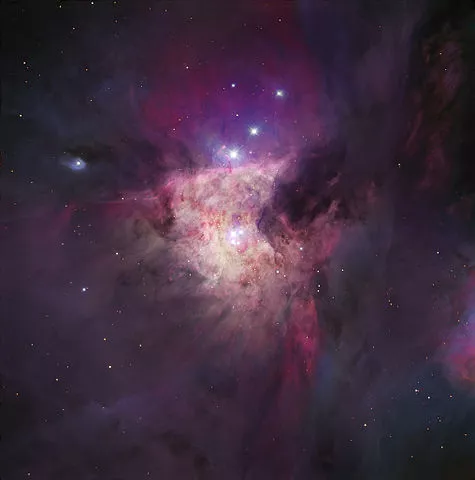
The Orion Nebula is arguably the finest of all nebulae within the Milky Way visible from the Northern Hemisphere. With a gaseous repository of 10,000 suns, and illuminated by a cluster of hot young stars, the clouds of Messier 42 — as it is also known — glow with fantastic colours and shapes, giving us a bird’s eye view of one of the greatest star forming nurseries in our part of the Milky Way. Messier 42 is a complex of glowing gas, mostly hydrogen but also helium, carbon, nitrogen, and oxygen in decreasing amounts, located 1,500 light-years away. At its very heart, we find the Trapezium, a group of four very hot stars that illuminate the nebula. They are the brightest of an extended cluster of several thousand young stars many of which lie unseen within the opaque gas and dust. Amazingly, whilst the Orion Nebula is easy to identify with the unaided eye, there is apparently no written record of its existence before the 17th century. This image is based on data acquired with the 1.5 m Danish telescope at the ESO La Silla Observatory in Chile, through three filters (B: 60 s, V: 30 s, R: 21 s). East is at the upper right corner and North is at the lower right. Image: ESO/IDA/Danish 1.5 m/R.Gendler, J.-E. Ovaldsen, and A. Hornstrup (CC BY 4.0)
Theta2 Orionis
The components of Theta2 Orionis are designated Theta2 Orionis A, B and C. The star system is separated from the Trapezium Cluster by only 2 arcminutes. The three stars appear in a line, each separated by about an arcminute from the next. Two of the components are supernova candidates. The system lies approximately 1,500 light years away.
The brightest component, Theta2 Orionis A, is the hottest, bluest and most massive of the group. It is also the most evolved, classified as a blue subgiant of the spectral type O9.5 IVp. The star has a mass 39 times that of the Sun and shines with 107,000 solar luminosities with a surface temperature of 34,900 K. It is a fast spinner, with a projected rotational velocity of 133 km/s. With an apparent magnitude of 5.02, the star is visible to the unaided eye and slightly brighter than the brightest component of the Trapezium Cluster.
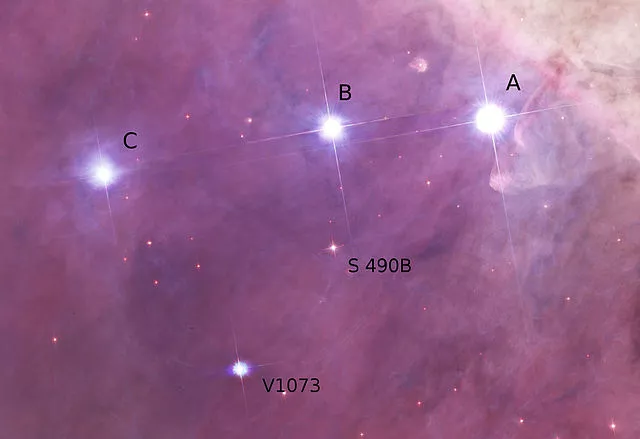
Theta-2 Orionis, image: Ian Nartowicz (original image: NASA, ESA, M. Robberto (Space Telescope Science Institute/ESA) and the Hubble Space Telescope Orion Treasury Project Team)
Theta2 Orionis A is a multiple star system. One of the companions appears only 0.3 arcseconds away, which corresponds to a physical separation of 147 astronomical units. Another is much closer, about 0.47 astronomical units from the primary. The companions are believed to be early A- or late B-type stars with masses of 7 to 9 solar masses.
Theta2 Orionis B is also massive enough to go out as a supernova. It has a mass of 14.8 solar masses and a radius 4.3 times that of the Sun. It is a blue main sequence star of the spectral type B0.7 V. With an effective temperature of 29,300 K, it is 12,300 times more luminous than the Sun. The star is less than 2 million years old. It shines at magnitude 6.380 and is theoretically visible to the unaided eye.
Theta2 Orionis C is also still on the main sequence. It has the stellar classification B5 V. With a mass 4.86 times that of the Sun, it is not massive enough to go out as a supernova. It shines with 616 solar luminosities with a surface temperature of 13,800 K. Its estimated age is less than 1 million years. It is the faintest of the three components of Theta2 Orionis, shining at magnitude 8.18.
Theta2 Orionis C is classified as an Orion variable, a young star that shows eruptive variations in brightness over irregular periods. It has the variable star designation V361 Orionis.
Orion Nebula
The Orion Nebula is a vast reflection/emission nebula stretching across 24 light years or 1 degree on the sky. The gas and dust cloud is located approximately 1,344 light years away. It lies in the Milky Way galaxy and is the nearest massive star forming region to the Sun, hosting countless new stars and very young clusters, reflection nebulae and neutral clouds of dust and gas.
Astronomers have detected about 700 stars in the process of being formed within the nebula. The most active star forming region within the nebula is known as the Kleinmann-Low Nebula (the Orion KL Nebula). It lies at the centre of the Orion Nebula and appears as the brightest part of the Orion Molecular Cloud 1 (OMC 1).
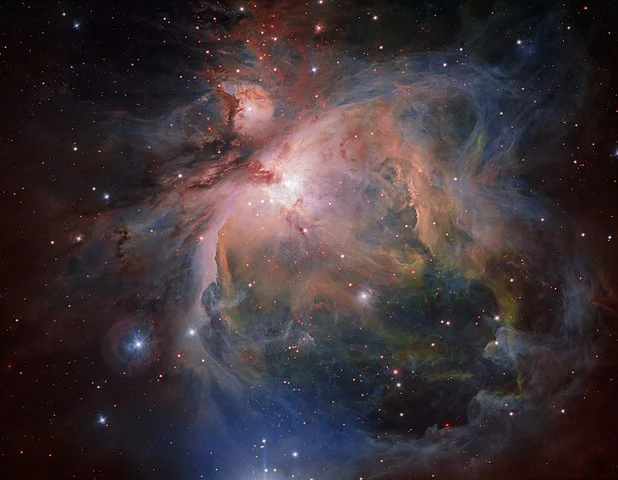
The Orion Nebula (Messier 42), image: ESO/G. Beccari
With an apparent size of 65 by 60 arcminutes and an apparent magnitude of 4.0, the Orion Nebula is easily visible to the unaided eye, appearing as a fuzzy patch of light in the centre of Orion’s Sword.
The nebula is part of the larger Orion Molecular Cloud Complex, a star forming region that stretches across the entire constellation of Orion and includes many well-known deep sky objects, among them the Flame Nebula, the Horsehead Nebula, Barnard’s Loop, and the reflection nebula Messier 78.
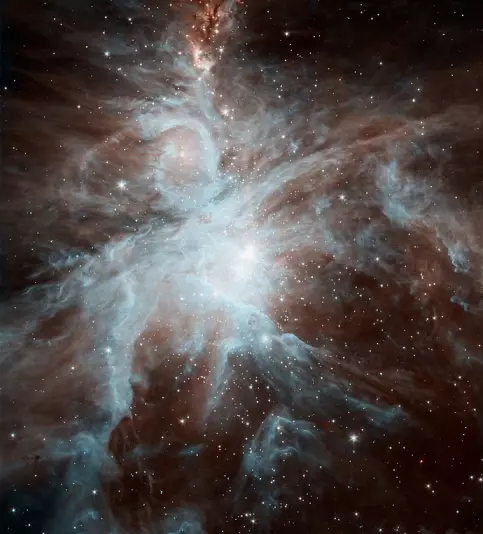
Orion Nebula by the Spitzer Space Telescope, image: NASA, JPL-Caltech, J. Stauffer (CC BY-SA 4.0)
In 2023, the massive young stars of the Orion Nebula were captured by NASA and ESA’s James Webb Space Telescope (JWST). The new observations of M42 have revealed hundreds of candidate planets with at least a dozen times the mass of Jupiter throughout the nebula.
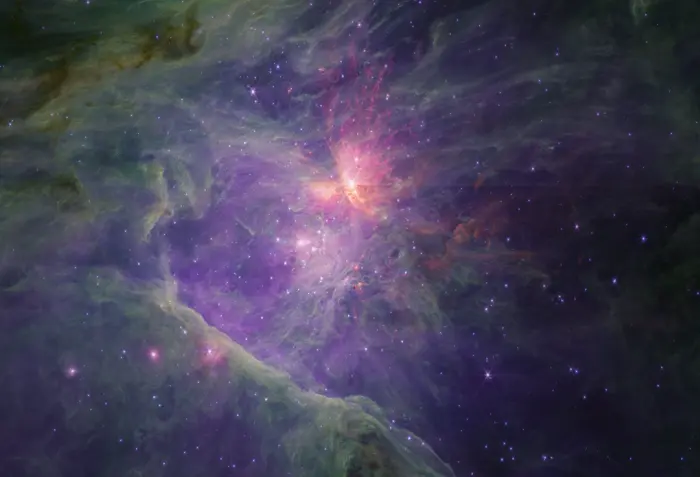
The NASA/ESA/CSA James Webb Space Telescope has observed the well-known Orion Nebula and Trapezium Cluster using the NIRCam instrument. The new images provide unprecedented spatial resolution and spectral sensitivity. On the left, the image from Webb’s NIRCam short-wavelength channel shows the nebula, its stars, and many other objects in unprecedent high definition in the near infrared. Many of the young stars are surrounded by dense disks of gas and dust which may be forming planets. In other cases, those disks are being destroyed by the intense ultraviolet radiation and strong winds from the most massive stars in the region. Many of these photoevaporating disks are visible if you zoom into the larger image. On the right, the image from Webb’s NIRCam long-wavelength channel reveals the gas, dust and molecules with unprecedented sensitivity in infrared, but at lower spatial resolution than in the short-wavelength image. The cavity is mostly filled with ionised gas, seen here in purple, while the surroundings have a mix of dust and molecular gas seen in reds, browns, and greens. The Bright Bay to the upper left is being eroded by the massive stars and there are many pillars of gas and dust which are being carved. Image credit: NASA, ESA, CSA; Science leads and image processing: M. McCaughrean S. Pearson (CC BY-SA 3.0)
Iota Orionis
Iota Orionis is the brightest part of Orion’s Sword. With an apparent magnitude of 2.77, it is the eighth brightest star in Orion, after Rigel, Betelgeuse, Bellatrix, Saiph and the stars of Orion’s Belt. It lies approximately 1,343 light years away.
Iota Orionis is a multiple star system consisting of three visible components – Iota Orionis A, B and C – the first of which is a spectroscopic binary star with a companion.
The three components of Iota Orionis A are catalogued as Iota Orionis Aa1, Aa2 and Ab. The primary component is a massive hot blue star of the spectral type O9 III. The star has a mass 23.1 times that of the Sun and has expanded to a size of 8.3 solar radii as it evolved away from the main sequence. It is 68,000 times more luminous than the Sun with a surface temperature of 32,500 K. The star’s estimated age is only 4 – 5.5 million years.
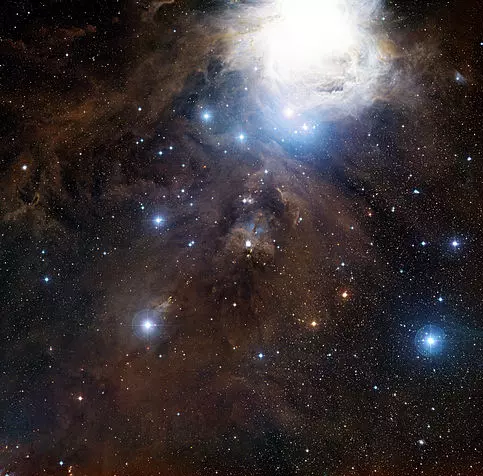
Iota Orionis and NGC 1980, image: ESO/Digitized Sky Survey 2
The spectroscopic companion, Iota Orionis Aa2, is blue subgiant or giant star of the spectral type B0.8 III/IV. It is slightly smaller and less massive than the primary, with a mass of 13.1 solar masses and a radius 5.4 times that of the Sun. It is less luminous as well, shining with 8,630 solar luminosities with an effective temperature of 27,000 K. The star appears to be older than its close companion, with an estimated age of 9.4 million years. This suggests that the two stars were not formed together, but that the system was created through a capture in an encounter between two binary systems.
A 2001 study suggested that the runaway stars AE Aurigae (the star that illuminates the Flaming Star Nebula in Auriga) and Mu Columbae may have been the original binary companions to the Iota Orionis primary and secondary. A subsequent study showed that Iota Orionis, Mu Columbae and AE Aurigae were indeed close together 2.5 million years ago and that they were ejected from the Trapezium Cluster. The two components of the Iota Orionis system orbit each other with a period of 29.1338 days. The primary component is formally named Hatysa. The origin of the name is uncertain.
The component Iota Orionis Ab is believed to be a blue subgiant of the spectral type B2 IV. It is separated by 155 milliarcseconds from the spectroscopic binary.
Iota Orionis B is a blue giant of the spectral type B8 III. It has a mass 5.12 times that of the Sun and a surface temperature of 18,000 K. It is believed to be about 3 million years old. It appears 11 arcseconds away from the component A. This corresponds to a physical separation of about 5,000 astronomical units. The star is classified as an Orion variable and has the variable star designation V2451 Orionis.
Iota Orionis C an A0-type star appearing at a separation of 49 arcseconds from the primary.
NGC 1980
Iota Orionis is a member of an open cluster catalogued as NGC 1980 (Collinder 72). Nicknamed the Lost Jewel of Orion, NGC 1980 is a young open cluster with an apparent magnitude of 2.5 and an apparent size of 14 by 14 arcminutes. It was discovered by the German-born British astronomer William Herschel on January 31, 1786. The cluster lies 1,793 light years away. It is sometimes called the Lower Sword.
Location
Orion’s Sword is very easy to find because it lies within the hourglass figure of Orion, just below the Belt of Orion, one of the most recognizable asterisms in the night sky. The constellation figure of Orion is outlined by an hourglass-shaped asterism formed by the bright stars Betelgeuse, Bellatrix, Rigel, Saiph, and the stars of Orion’s Belt: Alnitak, Alnilam, and Mintaka. The Belt stars point toward Sirius in one direction and toward the Pleiades in another. Meissa marks the Hunter‘s head and his shield is formed by six stars and star systems that share the designation Pi Orionis. Completing the picture, the Sword of Orion is located below Alnitak and Alnilam, the leftmost and central stars of Orion’s Belt.
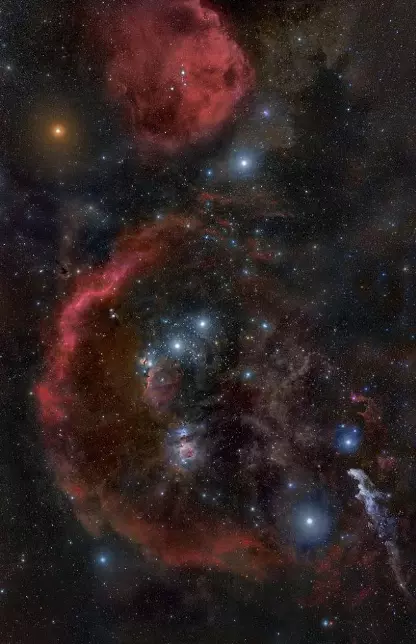
Photo taken by Rogelio Bernal Andreo in October 2010 of the Orion constellation showing the surrounding nebulas of the Orion Molecular Cloud complex. Also captured is the red supergiant Betelgeuse (top left) and the famous belt of Orion composed of the OB stars Alnitak, Alnilam and Mintaka. To the bottom right can be found the star Rigel. The red crescent shape is Barnard’s Loop. The photograph appeared as the Astronomy Picture of the Day on October 23, 2010. Image: Rogelio Bernal Andreo
The best time of year to see Orion’s Sword is during the winter months, when Orion dominates the evening sky. For northern observers, Orion is visible from late summer, when it rises in the east just before dawn, until spring. It stays below the horizon from May to July. For observers in the southern hemisphere, the best time to see Orion is summer.
Orion is one of the equatorial constellations, which means that it is visible from any location on Earth for at least a part of the year. The entire constellation is visible from locations between the latitudes 85° N and 75° S.